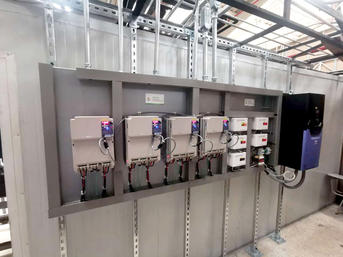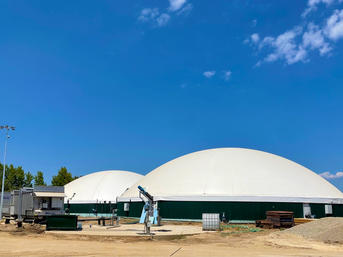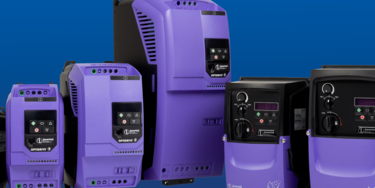
Variable Frequency Drives (VFD)
Sumitomo Drive Technologies by Invertek Drives is dedicated to the design and manufacture of sophisticated Variable Frequency Drives, used to control electric motors in a wide variety of industrial and energy saving applications.
Enjoy Easy, Precise & Reliable Motor Speed Control with Invertek VFDs
The complete package for world class motor control

Variable Frequency Drives (VFDs) Offered
Invertek Optidrive E3 VFD Drives
Compact, reliable and easy to use drive
Simply power this VFD on, and your Optidrive E3 is up and running, providing precise motor control and energy savings using the factory settings.
Invertek Optidrive P2 VFD Drives
High performance and easy to use drive
With the Optidrive P2 variable frequency drive, even the most demanding applications can be conquered with ease thanks to its combination of high performance and ease of use.
IP66/NEMA 4X Variable Frequency Drive Options
Optidrive variable frequency drives (VFDs) provide advanced motor control with ease of setup and operation. They are also capable of operating in some of the harshest environments thanks to the IP66 / NEMA 4X-rated enclosures available across the E3 and P2 ranges.
Designed to withstand dust, moisture, and chemicals, IP66 / NEMA 4X variable frequency drives are ideal for applications involving a lot of dust, moisture, and chemicals. Suitable for conveyors, mixers, packaging, ventilation systems, and liquid pumps, they are a perfect choice. The high level of protection allows the drives to be placed directly on, or very close to, the motor and application without needing a cabinet. This makes them an ideal solution for outdoor applications, retrofitting, and equipment requiring washdown.
In addition to their coated heatsinks and protected enclosures, they have a design that eliminates areas where dirt can lodge, making them perfect for applications requiring high hygiene standards.
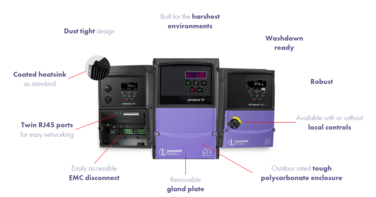
Variable Frequency Drive Resources
What is a Variable Frequency Drive (VFD) ?
A variable frequency drive (VFD) is an electronic device that controls the speed of AC induction motors. Another term for Variable Frequency Drives is an Inverter. To understand how a VFD drive works and how it can be used, we need to understand the history of motor controllers and how induction motors work.
Controlling the speed of electric motored equipment has always been useful in industry. Nearly every process that uses a motor will benefit from speed control. In addition to improving the process, there are often significant energy savings (especially with pumps and fans).
In the past, motors were controlled in a variety of ways before electronic controllers became available. A series of resistors were used to control the field current on a DC motor, or other motors were used. With Thyristors, the first power semiconductors, phase control of DC motors became possible in the 1950s. These DC drives are still manufactured and in wide use today.
However, the challenge has always been to control the speed of the AC induction motor, also known as the Asynchronous motor. While a DC machine usually has two wound parts (the field and armature windings) as well as brushes and a commutator, the AC machine has a simple, fixed winding (the stator) and a rotor. The rotor usually consists of conductors formed by casting Aluminium or Copper in the iron core. There are no brushes or commutator.
The machine is, therefore, cheaper, simpler, and more reliable. It is not surprising that these machines are the best choice for speed control for power transmission equipment and applications across the world.
Optidrive Resource Videos
Case Studies
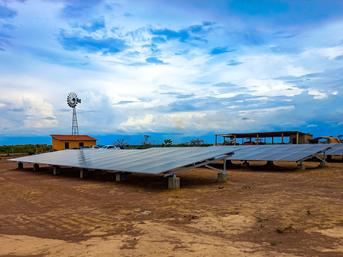
Off-grid farm reduces energy costs and increases irrigation abilities with solar pumping technology
Variable Frequency Drives FAQs
Are Invertek VFDs IP66/Nema rated?
Yes! We have Outdoor-rated enclosed variable frequency drives for direct machine mounting, dust-tight, and ready for washdown duty.
The Optidrive E3 Variable Frequency Drive is built with tough polycarbonate plastics specifically chosen to withstand degradation by ultraviolet (UV), greases, oils, and acids. Also, this VFD is robust enough not to be brittle at -20oC
Is there a Variable Frequency Drive that is washdown ready?
With a sealed ABS enclosure and corrosion-resistant heatsink, the Optidrive E3 IP66 VFD is ideal for high-pressure washdown applications.
What Modes Does the Optidrive E3 VFD have?
Switch modes at the touch of a button to optimize the Optidrive E3 Variable Frequency Drive for your application.
Industrial Mode optimizes the Optidrive E3 VFD for load characteristics of typical industrial applications. Applications include: Conveyors, Mixers, and Treadmills
Pump Mode makes energy-efficient pump control easier than ever. Applications include Dosing Pumps, Borehole Pumps, Transfer Pumps, Swimming Pools, and Spas Fountains.
Fan Mode (inc. fire operation) makes air handling a breeze, ideal for simple HVAC systems. Applications include Air Handling Units, Ventilation Fans, Circulating Fans, Air Curtains, and Kitchen Extract.
Why is the Optidrive P2 VFD considered a high performance drive?
Sensorless Vector Control: Up to 200% torque from zero speed ensures reliable starting for your VFD and accurate speed control under all load conditions.
PM Motor Control: We consider these VFDs as future-proof. The Optidrive P2 Variable Frequency Drive allows upgrades to the latest generation of high-efficiency permanent magnet motors.
I/O & Communications: Optidrive P2 VFD supports a wide range of interfaces to machine control systems.
Are There Filters in Optidrive P2 VFDs?
Built-in EMC Filter: An internal filter in every Optidrive P2 VFD saves cost and time for installation.
What safety features does the OptiDrive P2 Variable Frequency Drive offer?
Optidrive P2 VFD features a safe torque-off function to allow simple integration into machine-critical safety circuits.
- Simple machine design reduces component costs, saves panel space, and minimizes installation time
- Faster shutdown and reset procedures reduce system maintenance time
- Better safety standards compared to the mechanical solution
- Better motor connection. Single cable with no interruption
How can I manage my Variable Frequence Drive (VFD) parameters?
Managing VFD Parameters Optistick is easy with the Optistick Smart.
Smart is a convenient tool for transferring, extracting, storing, and copying drive parameters (ptb files).
- Transfer parameters between PC/phone and VFD memory
- Extract parameters from VFD memory
- Store/backup parameter sets
Copy parameters between VFDs of the same product range and power rating (size) for fast, accurate repeat drive programming
How can I simply update my VFD software?
OptiTools Studio enables you to update your Variable Frequency Drive (VFD) to the latest version of our drive software, meaning your drive is always operating with the most up-to-date features, functions, and performance levels
Can I use momentary Push Buttons on my Control Panel to Start and Stop the VFD?
Yes, Optidrive VFD products can be configured for momentary push buttons that Start and Stop the drive. Refer to the 'Analog and Digital Input Configurations' table in the product manual for detail of the required parameter settings.
Switches are (two wire):
Normally open, closed to Run.
Normally closed, open to Stop
Alternative Configuration is (three wire):
Normally open, closed to Run Fwd.
Normally closed, open to Stop
Normally open, closed to Run Rev.
The drive is required to be in Terminal mode to allow activation of this function.
Can I display speed in RPM on my Optidrive VFD?
Yes, Optidrive variable frequency drives allow all speed-related parameters to be displayed in RPM instead of Hz.
By setting the value of the ‘Motor-rated Speed’ parameter to the motor-rated speed in RPM, the Optidrive will display the motor speed and the speed-related parameters in RPM. When this parameter is set to zero, the speed of the motor will be displayed in Hz.
In addition, an application note for use of this feature is provided for selected products:
How can you hide certain parameters in the Optidrive P2 & E3 VFDs?
Step 1 - Within the parameter editor window of OptiTools studio, click >"Add Virtual Drive" as per the same rating and type of drive that you want to hide certain parameters in.
Step 2- Enter a value of P6-30 + 100 into P1-14 (P2 products) or P-37 + 200 (E3 products).
Step 3 - In the "Visible" column (far right-hand side of the window), Un-tick the parameters that are to be hidden.
Step 4 - Download the parameter file to the variable frequency drive.
Completed: When navigating through the parameters in the VFD drive, the Unticked parameters should now be hidden.
How many and what types of expansion modules can you add to the P2 Variable Frequency Drive (VFD?)
Optidrive P2 Variable Frequency Drive (VFD) has one slot for an option module. This can be used for any one of the following.
- Fieldbus Interface Module
- Profbus DPV1
- DeviceNet
- EtherNet IP
- EtherCat
- Modbus TCP
- I/O Expansion
- Extended IO
- Cascade Option
- Encoder Interface
- TTL Encoder Interface
- HTL Encoder Interface
What does a variable frequency drive do?
The variable frequency drive (VFD) is an electronic component used to control an AC induction motor or synchronous motor. VFDs are used to control the torque, speed, and direction of a motor, allowing a motor to be started and accelerated smoothly to its desired speed at a controlled speed. Furthermore, there is an option to control deceleration, as well as braking when required. Variable frequency drives (VFDs) enable you to use a single motor for various equipment and processes that may require different speeds.
What is difference between VSD and VFD?
Variable frequency drives (VFDs) and variable speed drives (VSDs) differ in that VFDs are AC drives only, while VSDs can be either AC drives or DC drives. VFDs vary the speed of an AC motor by varying the frequency to the motor. VSDs referring to DC motors, vary the speed by varying the voltage to the motor.
When working with motors that require fast speed-ups and slow-downs, VSD drives are a good choice. The VFD is designed for the continuous operation of electrical motors.
What is the advantage to variable frequency drive motors?
Enhanced Torque control, Reduced energy consumption,
- A simple installation process
- Energy demand is reduced at peak times
- Reduces power consumption when not needed
- Speed is fully adjustable
- Controlled acceleration, starting, and stopping
- Maintains speed of equipment, making drives perfect for industrial machinery like mixers, grinders, and crushers
- Provides versatility
- Self-diagnosis and communication
- Enhanced overload protection
- Software programming and PLC-like functionality
- Digital inputs and outputs
- An analog input/output system
- Reduced mechanical and thermal stresses on motors and belts during starting
Is a variable frequency drive an inverter?
Yes. Other names for a VFD include AC Drive or Inverter
- Variable speed drive
- Adjustable speed drive
- Adjustable frequency drive
- VFD control
- Variable-voltage/variable-frequency drive
What applications can I use a VFD?
The following applications can benefit from VFDs:
- Conveyor Systems
- Automated Warehouses
- Elevators
- Screw Presses
- Pumps
- AC Motors
- Weighing Machines
- Extruders
- Cranes and Hoists
- Constant Air Volume Systems
- Boilers and Forced Draught Fans
- Cooling Towers
- Agitators
- Rollers
- Drying Machines (Furnace Fans)
- Carts
- Wood Working Machines
- Packaging Machines
- Multilevel Car Parking Towers
- Blowers
What are the different types of variable frequency drives?
The two types of inverters are a single phase converter and a three phase VFD
- A single-phase converter outputs three phases with a voltage of 220V from a single-phase 220V network.
- Three-phase VFDs are connected to three-phase 380V networks and output three phases at 380V as output voltage.
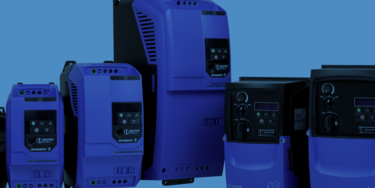
About Invertek Drives
Since 2019, Invertek Drives has been part of Sumitomo Heavy Industries, Ltd., Invertek's integration into Sumitomo Heavy Industries, Ltd. has strengthened its capabilities of developing the next generation of variable frequency drive (VFD drive) technology, capable of increasing the energy efficiency of electric motors and, in turn, reducing energy use globally and reducing carbon emissions. As a VFD manufacturer, we know we manufacture and ship the best inverters on the market.
Looking for a Variable Frequency Drive price?
